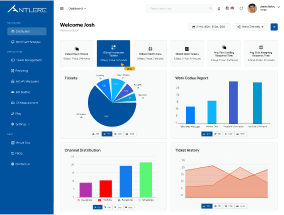Top 7 Metrics That Matter Most in Digital Experience Analytics
In 2025, businesses are no longer judged solely on their products or pricing they are judged on experience. The impressions a user has with your digital platforms comes with every click, scroll, or any interaction a user has with your brand. And companies that do not take the time to track these experiences are going to be left with fewer customers in favor of companies that prioritize a smoother and more engaging digital journey.
A PwC report shows that after one bad experience, 32% of customers stop doing business with a brand they love. Due to this, digital experience analytics are no longer just a performance metric, but rather a survival metric. Tracking the right metrics allows you to see where friction begins, how you can drive engagement, and ultimately give customers meaningful experiences that delight them at every digital touchpoint.
Here are seven of the most important metrics you should track in your organization come 2025.
1: Page Load Time: The First Impression Metric
Among digital experience factors, Page load time is still one of the most important. Google (2024) states that over 53% of mobile users abandon a site that takes longer than three seconds to load.
Users abandon websites and apps that are slow to respond and are unlikely to return. Businesses focusing on speedy experiences lower bounce rate & top grade in SEO rankings too. A straightforward example is that an e-commerce retailer can gain conversions if their website load time is 4 seconds and they reduce it to 2 seconds.
2: Customer Satisfaction Score (CSAT)
CSAT, short for Customer Satisfaction Score, is how customers perceive a single interaction with your company. CSAT provides an instant view of user sentiment either after a purchase (purchase CSAT) or an interaction with customer support (response CSAT).
When you survey your customers regularly and connect how they respond to your interactions with them digitally, you can know what works and what does not. As an example, a SaaS company could discover that customers who had slow on-boarding rates gave lower CSAT scores, indicating a specific friction point to focus on fixing.

3: Net Promoter Score (NPS)
Net Promoter Score (NPS) is an indication of the likelihood of your customers recommending your brand. It goes beyond merely reflecting satisfaction it demonstrates loyalty. In other words, a higher NPS translates into the fact that customers are not just happy but are ready to be your advocates.
- Measures loyalty across time: Helps to measure the success of the digital strategy in the long term.
- It easily segments promoters and detractors which is a perfect fit for the follow-up strategies to ensure retention.
- Predicts revenue: Businesses with a higher Net Promoter Score can be found to be consistently more profitable than their competitors
Companies with industry-leading NPS grow more than twice as fast as their competitors (Bain & Company).
4: Conversion Rate: Turning Visitors into Customers
Conversion rate is at the core of digital experience analytics. Conversions are how efficiently your digital experience is getting users to convert, whether that be making a purchase, signing up for a newsletter, or filling out a demo request form.
While low conversion rates often elicit a sense of dread, they can also be a warning sign that you need to dig into design, navigation, and messaging issues. Taking a look at conversion paths can help businesses identify bottlenecks and test out various solutions, like improving CTAs, optimizing landing pages or simplifying checkout.
5: Bounce Rate and Engagement Metrics
The rate at which visitors leave after viewing a single page. Jumping back to bounce rates can point toward poor content relevance or low-quality UX, it is essential to understand bounce rate in context with other engagement metrics like average session duration, pages per visit, and so on.
On the other hand, a blog with a high bounce rate but also with a long time-on-page can be perfectly working, because visitors find the content useful and leave happy. In contrast, if an e-commerce product page has a high bounce and low time-on-page, then something is wrong.
6: Session Replay and Heatmaps: Understanding Behavior in Action
The above is invaluable data beyond numbers, qualitative insights come from things like session replays and heatmaps. They demonstrate precisely how users are using your site– where they click, where they drop off, and how far they scroll down.
For example, a session replay may show that users are dropping off a long sign-up form. For example, heatmaps may reveal that a strategic CTA button sits below the fold. Integrating these insights with quantitative data provides businesses with a holistic view of user behavior, allowing them to create experiences that are easier to utilize.
7: Customer Effort Score (CES)
A Digital Customer Effort Score gauges how effortlessly users engage with your digital assets. More effort-free, equals a higher overall experience.
If a banking app offers instant money transfer in just a single step, it would get a higher score on CES than a banking app, which has multiple steps before the money gets transferred. Gartner found that 96% of customers exposed to high-effort service have become disloyal customers, while only 9% of customers who are exposed to low-effort interactions become disloyal.

Comparative Table: Key Metrics in Digital Experience Analytics
Metric | What It Measures | Why It Matters in 2025 |
Page Load Time | Speed of website/app response | Impacts SEO, bounce rate, conversions |
CSAT | Customer satisfaction after interactions | Direct insight into user sentiment |
NPS | Loyalty and likelihood of recommendations | Predicts long-term growth and advocacy |
Conversion Rate | Percentage of users taking desired action | Core measure of digital success |
CES | Effort required by customers | Directly linked to loyalty and retention |
Session Replay & Heatmaps | Behavioral patterns and navigation flows | Identifies UX friction and design flaws |
Bounce Rate & Engagement | Visitor activity and content effectiveness | Balances retention with content value |
Compelling Statistics That Support Need-for Digital Experience Analytics
- PwC (2024): 86% of buyers will pay more to ensure a great customer experience.
- A 1 second delay in load time leads to a 7% decrease in conversions (Akamai, 2024).
- A positive relationship between employee engagement and customer satisfaction has been found; companies that actively manage CX metrics have 1.5x higher employee engagement (Forrester, 2024).
- Gartner (2024) states that 89% of the companies nowadays mainly compete on customer experience.
Conclusion: Building Experiences That Last
Customer experience is the key differentiator in this age of digital-first world. The answer lies in focusing on the seven vital metrics of digital experience analytics to replace educated guesswork and make decisions based on data that appeals to customers.
Page load time, NPS, CES, and session replays are only the suggestions that show what is broken and where lies the opportunity to delight. In 2025, the companies that will come out on top will be the ones that kept an eye on the signals in real time, optimized to the nth degree, and have the customer at the center of every digital engagement.
Because at the end of the day, each click is a touch point a chance to build loyalty or lose it.

Author









